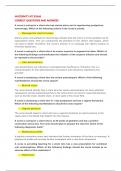Histologische onderzoekstechnieken
1 Inleiding
Celbiologen en histologen: onderzoeken structuur van cellen & weefsels → technische hulpmiddelen
2 Optische principes
2.1 Golflengte
3 belangrijke elementen bij microscopen:
Lichtbron
Specimen
Geheel van lenzen → licht gecontentreerd op specimen
Lichtmicroscoop: rechtsreek waarnemen via oculair/ detector
Elektronenmicroscoop: elektronenbundel via elektromagnetische spoelen → fluorescerend scherm
Specimen/ object: golflengte van licht/ elektronenbundel verstoren
Kleine subcellulaire structuren niet zichtbaar: te klein om golflengte te verstoren
2.2 Resolutie of scheidend vermogen
Interferentie: proces waarbij 2/ meerdere golven door combinatie elkaar versterken/ verzwakken
waardoor finaal een golf ontstaat die het resultaat is van de som van de combinerende golven
Beeld = geheel van additieve/ inhiberende inferentie van golven (= diffractie)
Brandpuntsafstand: afstand tussen de lens &
het punt waarin de stralen convergeren na
passage doorgeen de lens
Angulaire apertuur: helft van hoek α vd
lichtkegel vanuit het specimen doorheen de
objectieflens
Resolutie (r): kleinste afstand tussen 2 punten
waarbij deze punten nog als 2 afzonderlijke
punten kunnen gezien worden
golflengte 0.61 λ 0.61 λ
r= = =
brekingsindex∗sin α n sin α NA
NA= numerieke apertuur
Golflengte zichtbaar licht: 400-700 nm → 450nm bij lichtmicroscoop
Brekingsindex lucht: 1.0
Angulaire apertuur 70° en sin = 0.94
0.61∗450 nm
r= =292 nm
0.94
Verhogen door het medium: vb brekingsindex olie = 1.5
0.61∗450 nm
r= =196 nm
1.5∗0.94
Scheidend vermogen menselijk oog= 0.2 nm → vergroting van maximaal 1000x
2.3 Contrast
Dierlijke weefsels: bijna geen contrast → kleurstoffen (= toxic dus dode cellen)
, 3 De lichtmicroscoop
Baan van het licht:
1. Lichtbron
2. Condensorlens: licht gestuurd & geconcentreerd op
specimen ≠ vergrotingsfactor
3. Objectieflens: vlak boven specimen & vormt primair
beeld
NA bepaalt resolutie & vergroting
4. Oculair lens: primaire beeld opgevangen & vergroot
3.1 Fasecontrast microscoop
Contrast verhogen zonder weefsel te kleuren → levende weefsels
Werking: lichtbundel = verschillende lichtstralen met een gelijke
fase → stralen doorheen object => faseverschil (= nier
waarneembaar voor menselijk oog) → faseverschil omzetten in amplitudewijzigingen (= zichtbaar
voor menselijk oog)
Ring 1: zorgt voor fase
Ring 2: zorgt voor amplitudewijziging
3 soorten afbrekingen:
3.2 Differentieel interferentiecontrast (DIC) microscopie
Dezelfde principes als fasecontrastmicroscopen MAAR DIC microscoop = gevoeliger & 3D aspect door
het schaduweffect
3.3 Fluorescentiemicroscopie
Luminescentie: proces waarbij licht geabsorbeerd
wordt door een molecule waarna deze zelf licht
uitzendt → foton in geëxciteerte status
Excitatielicht: inkomend licht ( kortere
golflengte)
Emissielicht: uitgezonde licht ( langere
golflengte)
Fosforescentie: emissie van licht blijft bestaan na
belichting
Fluorescentie: enkel emissie tijdens het belichten
Photo bleaching: excitatie te lang →
veroorzaakt uitdoving waardoor geen emissie meer wordt
uitgezonden
Fluorescentiemicroscopen: werken met UV-licht → schadelijk voor
het oog
1 Inleiding
Celbiologen en histologen: onderzoeken structuur van cellen & weefsels → technische hulpmiddelen
2 Optische principes
2.1 Golflengte
3 belangrijke elementen bij microscopen:
Lichtbron
Specimen
Geheel van lenzen → licht gecontentreerd op specimen
Lichtmicroscoop: rechtsreek waarnemen via oculair/ detector
Elektronenmicroscoop: elektronenbundel via elektromagnetische spoelen → fluorescerend scherm
Specimen/ object: golflengte van licht/ elektronenbundel verstoren
Kleine subcellulaire structuren niet zichtbaar: te klein om golflengte te verstoren
2.2 Resolutie of scheidend vermogen
Interferentie: proces waarbij 2/ meerdere golven door combinatie elkaar versterken/ verzwakken
waardoor finaal een golf ontstaat die het resultaat is van de som van de combinerende golven
Beeld = geheel van additieve/ inhiberende inferentie van golven (= diffractie)
Brandpuntsafstand: afstand tussen de lens &
het punt waarin de stralen convergeren na
passage doorgeen de lens
Angulaire apertuur: helft van hoek α vd
lichtkegel vanuit het specimen doorheen de
objectieflens
Resolutie (r): kleinste afstand tussen 2 punten
waarbij deze punten nog als 2 afzonderlijke
punten kunnen gezien worden
golflengte 0.61 λ 0.61 λ
r= = =
brekingsindex∗sin α n sin α NA
NA= numerieke apertuur
Golflengte zichtbaar licht: 400-700 nm → 450nm bij lichtmicroscoop
Brekingsindex lucht: 1.0
Angulaire apertuur 70° en sin = 0.94
0.61∗450 nm
r= =292 nm
0.94
Verhogen door het medium: vb brekingsindex olie = 1.5
0.61∗450 nm
r= =196 nm
1.5∗0.94
Scheidend vermogen menselijk oog= 0.2 nm → vergroting van maximaal 1000x
2.3 Contrast
Dierlijke weefsels: bijna geen contrast → kleurstoffen (= toxic dus dode cellen)
, 3 De lichtmicroscoop
Baan van het licht:
1. Lichtbron
2. Condensorlens: licht gestuurd & geconcentreerd op
specimen ≠ vergrotingsfactor
3. Objectieflens: vlak boven specimen & vormt primair
beeld
NA bepaalt resolutie & vergroting
4. Oculair lens: primaire beeld opgevangen & vergroot
3.1 Fasecontrast microscoop
Contrast verhogen zonder weefsel te kleuren → levende weefsels
Werking: lichtbundel = verschillende lichtstralen met een gelijke
fase → stralen doorheen object => faseverschil (= nier
waarneembaar voor menselijk oog) → faseverschil omzetten in amplitudewijzigingen (= zichtbaar
voor menselijk oog)
Ring 1: zorgt voor fase
Ring 2: zorgt voor amplitudewijziging
3 soorten afbrekingen:
3.2 Differentieel interferentiecontrast (DIC) microscopie
Dezelfde principes als fasecontrastmicroscopen MAAR DIC microscoop = gevoeliger & 3D aspect door
het schaduweffect
3.3 Fluorescentiemicroscopie
Luminescentie: proces waarbij licht geabsorbeerd
wordt door een molecule waarna deze zelf licht
uitzendt → foton in geëxciteerte status
Excitatielicht: inkomend licht ( kortere
golflengte)
Emissielicht: uitgezonde licht ( langere
golflengte)
Fosforescentie: emissie van licht blijft bestaan na
belichting
Fluorescentie: enkel emissie tijdens het belichten
Photo bleaching: excitatie te lang →
veroorzaakt uitdoving waardoor geen emissie meer wordt
uitgezonden
Fluorescentiemicroscopen: werken met UV-licht → schadelijk voor
het oog



